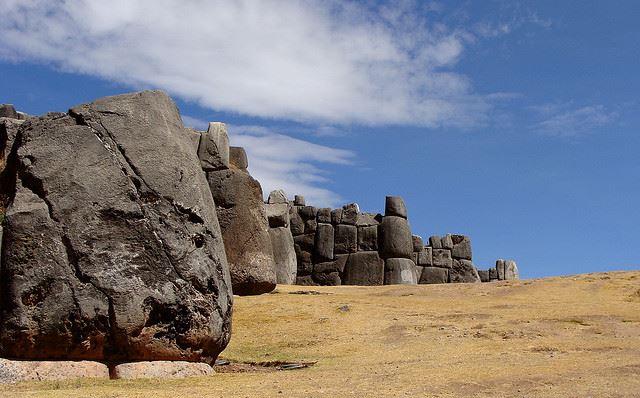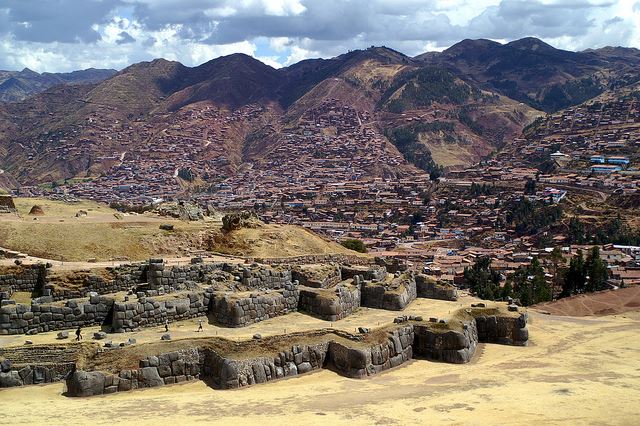Visitors to Cusco who are struck by how overwhelmingly Spanish the city now appears need only look up towards the incredible fort of Sacsayhuaman which looms over the city; an ever-present reminder that this was once the heart of the Inca empire. Sacsayhuaman’s three megalithic walls are the most astounding example we have of the Incas’ prowess as stone-masons and they are truly a sight to behold.

The head of the puma
To understand Sacsayhuaman’s importance we have to go back to the time times of Inca Manco Capac, the founder of the city of Cusco and one of the greatest Inca rulers. He laid the city out in the shape of a puma whose body was formed by the Tulumayo and Huatanay Rivers. His tail was the V where these two rivers converge and his heart was the Huacapata (Holy Square) containing the Coricancha. His head was – and still is – the fortress of Sacsayhuaman.
What’s in a name?
There are more spellings of Sacsayhuaman than there are recipes for Pisco Sour. Sacsayhuaman is the most common, Saksaywaman is the easiest to remember and Saksaq Waman is probably the closest to the original. Unsurprisingly there are is also considerable debate about what the name actually means, “with different groups holding that it means either ‘satiated falcon’, ‘speckled head’ or ‘city of stone’.” The choice is yours, but personally I’d say it’s hard to argue with the last option: there is a lot of stone up there!
Sacsayhuaman before the Spanish
The latest research suggests that the Incas were not the first people to build on the site: sections were built by the Killke as early as 1100, although most of what remains was built by the Incas from the 1440s onwards. Scholars are divided on what Sacsayhuaman was used for, but the variety of buildings and eminently defensible location mean it was probably both a religious complex and a defensive fortress.

At its peak, Sacsayhuaman was a vast complex. The inner precinct was a maze of narrow streets dominated by three large towers which were probably used for storage and as barracks. At the back of this section was a temple dedicated to the sun which some consider to have been the most sacred place in the Inca Empire. The inner fortress could have housed as many as ten thousand people under siege.
There are also several important sites outside the main fortress. The Qocha Chincanas, is thought to have been an Inca cemetery while the sacred spring of Calispucyo was integral to the initiation ceremonies of Inca boys. The Rodadero (“sliding place”), is a huaca or shrine centred around a peculiar rock formation which has had steps, benches and an Inca throne carved into it. The Rodadero was of great spiritual and ceremonial importance to the Inca people but it also served as a ‘recreational sliding area’ which can still by enjoyed by the young at heart.
Pizarro and beyond
In 1533 the city of Cusco was captured by Francisco Pizarro who installed Manco Inca Yupanqui as a puppet leader. In 1536 Manco Inca escaped Cusco. He quickly raised a mighty army of 200,000 Inca warriors and laid siege to Cusco, with Sacsayhuaman serving as the army HQ.
Sometime in May 1536, probably on about the 14th, a small group of Spanish cavalry escaped the city limits and stormed Sacsayhuaman. In the battle that ensued Juan Pizarro – Francisco’s younger brother – was hit on the head by a stone and he died from his injuries a few days later. In spite of this setback the Spanish were eventually able to reclaim Sacsayhuaman and – after 10 months of vicious fighting – the city of Cusco for their empire. For more detail check out the Wikipedia entry on The Siege of Cusco.

The Spanish soon dismantled many of the buildings at Sacsayhuaman and used the perfectly shaped stones as building materials for their churches, palaces and residences in Cusco. Today only a fifth of the complex remains, but it is still an extremely impressive sight: one can only imagine how incredible it once was.
Stone masonry
The Spanish may have used many of the stones at Sacsayhuaman for their own buildings, but the megaliths that make up the three main walls were simply too large to move. How, then, did the Incas manage to construct these walls?

The short answer is that nobody knows for sure. The Incas had not invented the wheel or the lever and they did not have access to draft animals, so moving these vast rocks – some of which weigh hundreds of tons – to the site was an incredible achievement. Add this to the fact that some of the rocks are laid so close together that you cannot slide even a piece of paper between them and you have one of the most astonishing feats of human engineering the world has ever known.
There is loads of conjecture about how they were able to achieve this (aliens, mirrors, stone-softening materials…), but this measured explanation resonates with me: Unravelling the mystery behind the megalithic stone walls of Saksaywaman.
For a very thorough introduction to Sacsayhuaman watch this video put together by Russian scientists. The narration is a bit stilted and annoying, but much of the content is great. If you don’t have time to watch all 39 minutes, there’s a very good section on stone processing at 23:24:
Sacsayhuaman today
These days Sacsayhuaman is a must-see for all visitors to Cusco. Most people drive to the site but if you’re feeling energetic (and are coping OK with the altitude) it’s a steep 30 minute walk from the Plaza de Armas. However you choose to enjoy Sacsayhuaman, the insights of your SA Expeditions guide will make it one of the highlights of your Peruvian adventure.
Sacsayhuaman is home to several festivals every year, the most important being Inti Raymi, the Festival of the Sun which takes place on 24 June (the Winter Solstice).


